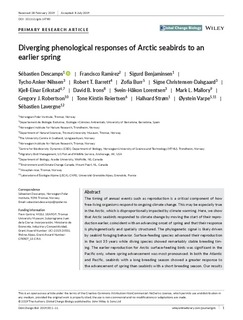Diverging phenological responses of Arctic seabirds to an earlier spring
Descamps, Sébastien; Ramírez, Francisco; Benjaminsen, Sigurd; Anker-Nilssen, Tycho; Barrett, Robert; Burr, Zofia; Christensen-Dalsgaard, Signe; Erikstad, Kjell-Einar; Irons, David B.; Lorentsen, Svein-Håkon; Mallory, Mark L.; Robertson, Gregory J.; Reiertsen, Tone Kristin; Strøm, Hallvard; Varpe, Øystein; Lavergne, Sébastien
Peer reviewed, Journal article
Published version

Åpne
Permanent lenke
http://hdl.handle.net/11250/2614272Utgivelsesdato
2019Metadata
Vis full innførselSamlinger
- Scientific publications [1392]
Originalversjon
10.1111/gcb.14780Sammendrag
The timing of annual events such as reproduction is a critical component of how free‐living organisms respond to ongoing climate change. This may be especially true in the Arctic, which is disproportionally impacted by climate warming. Here, we show that Arctic seabirds responded to climate change by moving the start of their reproduction earlier, coincident with an advancing onset of spring and that their response is phylogenetically and spatially structured. The phylogenetic signal is likely driven by seabird foraging behavior. Surface‐feeding species advanced their reproduction in the last 35 years while diving species showed remarkably stable breeding timing. The earlier reproduction for Arctic surface‐feeding birds was significant in the Pacific only, where spring advancement was most pronounced. In both the Atlantic and Pacific, seabirds with a long breeding season showed a greater response to the advancement of spring than seabirds with a short breeding season. Our results emphasize that spatial variation, phylogeny, and life history are important considerations in seabird phenological response to climate change and highlight the key role played by the species’ foraging behavior.
